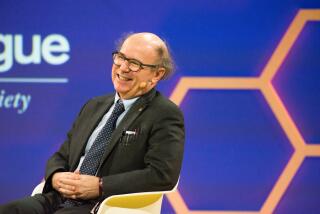BOOK REVIEW : Explaining Small but Important Matters : TAMING THE ATOM: The Emergence of the Visible Microworld, <i> by Hans Christian von Baeyer,</i> Random House, $23, 226 pages
- Share via
Physics and philosophy both seek to discover the ultimate reality, so it is not surprising that they influence each other and that their questions and answers are often analogous.
It is no accident (as the Marxists used to say) that the Enlightenment and its commitment to reason followed on the heels of Newton’s creation of modern physics three centuries ago.
Newton showed that the complex physical world--objective reality--is ruled by unbending, simple laws, which can be discovered by reason.
This model of knowledge is very powerful and very seductive. It provides a coherent worldview, and it exerts a strong pull on common sense and on all of our efforts to know the world.
Alas, however, we have learned in this century that neither in physics nor in philosophy is it the whole story, and therein lies one of the central paradoxes of our time.
Physics made the discovery first.
In the early part of this century, researchers learned that Newton’s physics was accurate only for a small class of phenomena--the world we see every day. But atoms, the building blocks of matter, were governed by quantum physics, which had different and seemingly incomprehensible rules altogether.
Unlike classical physics, which has clearly defined masses, objects and bodies in motion, in quantum physics, it’s impossible to put your finger on exactly what you’re studying. When you measure an electron, it is a particle; otherwise it is a wave. Matter and vacuum merge into one. The observer is at least as important as the thing observed. There is no certainty; probability is the best we can hope for.
No one knows what this means or what to make of it. The physicist Richard Feynman put it bluntly: “Nobody understands quantum mechanics.”
But Hans Christian von Baeyer, a physicist at the College of William and Mary in Virginia, makes a good stab at explaining the state of affairs in “Taming the Atom,” a book that traces atomic theory from Democritus to the present, with speculation about the future.
Over the centuries, the effort to understand atoms has been undertaken by philosophy, by experiment, by mathematical analysis and by art, and Von Baeyer gives each of them its due.
As he makes clear, the dilemma of atomic theory--and the dilemma of all knowledge--is captured in the dispute between Albert Einstein and Niels Bohr over quantum physics.
Einstein, whose theories did much to get quantum mechanics going, nonetheless remained a realist throughout his life. For him, quantum mechanics was a useful mathematical tool, but it could not be the ultimate explanation of the physical world. “God does not play dice,” he said. The real world exists whether it is observed or not.
Bohr, on the other hand, as virtually all physicists do today, accepted the quantum as an accurate statement of the basic nature of the universe. He chose either to ignore or not worry about its bizarre and incomprehensible implications.
Except for a few renegades here and there, the view of contemporary physics is that quantum mechanics works extraordinarily well, and philosophy is somebody else’s problem.
But what a problem it is! “Inside the atom reality seems to dissolve into enigma,” Von Baeyer writes. Elsewhere he says, “Studying an atom is like examining the surface of a mirror. If you scrutinized it too closely, you suddenly realize that you are looking at yourself.”
Which is, after all, a good description of the state of all knowledge in the post-structuralist era. Is the meaning of a written text in the mind of the author or in the mind of the reader?
There is a large library of writing on this question, but all I wish to do here is point out the parallel with the Einstein-Bohr debate over the quantum.
Einstein, the realist, would say that a text has an objective meaning. Bohr would take the other side. In contemporary literary criticism, he would be a deconstructionist.
This basic debate about the nature of truth overflows into many areas of thought. We have learned about “the social construction of reality.”
Observers are not passive. They have a large say in creating the social realm. Exactly how much is a subject of great and ongoing debate, which is not likely to be resolved any time soon. Nor are the dilemmas of quantum physics, though Von Baeyer discusses some potential resolutions.
Unfortunately, though the topic is important and Von Baeyer’s approach is original and thoughtful, his prose is sometimes flat. The pure-science parts take a little slogging to get through.
Nonetheless, there is much to commend this book. In what other book of physics will you find sources that include Alice in Wonderland, the Wizard of Oz, Samuel Johnson, Plato, Antoine de Saint-Exupery and Tom Stoppard?

